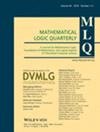On the variety of strong subresiduated lattices
IF 0.4
4区 数学
Q4 LOGIC
引用次数: 0
Abstract
A subresiduated lattice is a pair , where A is a bounded distributive lattice, D is a bounded sublattice of A and for every there exists the maximum of the set , which is denoted by . This pair can be regarded as an algebra of type (2, 2, 2, 0, 0), where . The class of subresiduated lattices is a variety which properly contains the variety of Heyting algebras. In this paper we study the subvariety of subresiduated lattices, denoted by , whose members satisfy the equation . Inspired by the fact that in any subresiduated lattice whose order is total the previous equation and the condition for every are satisfied, we also study the subvariety of generated by the class whose members satisfy that for every .
关于强次边值格的多样性
子边值格是一对(A,D)$(A,D)$,其中A是有界分配格,D是A的有界子格,并且对于每个A,b∈A$A,b\在A$中存在集合{d∈d:A∧d≤b}$\l轨道d\在d:A楔d\le b\l轨道$中的最大值,其由→ b$a\右箭头b$。这对可以看作是一个代数(A,∧,→ , 0,1)$(A,\wedge,\vee,\rightarrow,0,1)$的类型(2,2,0,0),其中D={A∈A:1→ a=a}$D=\l在a:1\rightarrowa=a\rbrace$中竞速a\。次边值格类是一个适当包含Heyting代数的变种的变种。在本文中,我们研究了由S表示的次边值格的子变种□ $\mathrm{S}^{\Box}$,其成员满足等式1→ (a∧b)=(1→ a)∧(1→ b)$1\rightarrow(a\vee b)=(1\rightarrowa)\vee(1\rigightarrowb)$。受以下事实的启发:在阶为全的任何次边值格中,前面的方程和条件a→ b∈{1→ b,1}$a\rightarrow b\in\lblase 1\rightarrowb,1\rbrace$对于每个a,b$a,b$都满足,我们还研究了S的亚变种□ $\mathrm{S}^{\Box}$由其成员满足→ b∈{1→ b,1}$a\rightarrowb\in\lblase 1\rightarrow b,1\rbrace$对于每个a,b$a,b$。
本文章由计算机程序翻译,如有差异,请以英文原文为准。
求助全文
约1分钟内获得全文
求助全文
来源期刊
CiteScore
0.60
自引率
0.00%
发文量
49
审稿时长
>12 weeks
期刊介绍:
Mathematical Logic Quarterly publishes original contributions on mathematical logic and foundations of mathematics and related areas, such as general logic, model theory, recursion theory, set theory, proof theory and constructive mathematics, algebraic logic, nonstandard models, and logical aspects of theoretical computer science.

 求助内容:
求助内容: 应助结果提醒方式:
应助结果提醒方式:


